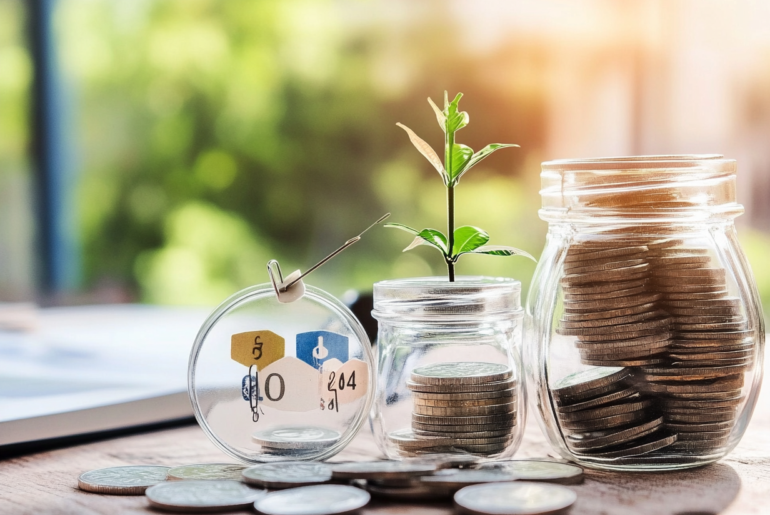This article may contain references to products or services from one or more of our advertisers or partners. We may receive compensation when you click on links to those products or services. Nonetheless, our opinions are our own.
The information presented in this article is accurate to the best of our knowledge at the time of publication. However, information is subject to change, and no guarantees are made about the continued accuracy or completeness of this content after its publication date.
Albert Einstein famously called compound interest the “eighth wonder of the world,” adding, “He who understands it, earns it; he who doesn’t, pays it.” This profound force transforms modest savings into substantial wealth over time, making it the cornerstone of long-term financial success. Let’s explore how compounding works, why it’s so powerful, and how everyday investors can harness it using common financial instruments.
Understanding Compounding
Compounding occurs when earnings on an investment generate their own earnings. Unlike simple interest, which grows linearly, compound interest grows exponentially because returns are reinvested. The formula for compound interest is:
A = P(1+r/n)nt
Where:
A = Final amount
P = Principal (initial investment)
r = Annual interest rate
n = Number of times interest is compounded per year
t = Time in years
Real World Applications
The power of compounding is not an abstract concept. It thrives in everyday financial tools and strategies accessible to most investors. High-yield savings accounts and certificates of deposit (CDs), for instance, offer a low-risk introduction to compounding. These instruments provide predictable, albeit modest, returns.
For example, a $10,000 deposit in savings account paying a 5% interest rate will become $16,470 in 10 years, assuming monthly compounding. Over 30 years, this seemingly small investment balloons to nearly $44,600, even without additional contributions. While inflation may erode some purchasing power over time, these vehicles demonstrate how steady, risk-averse compounding can still generate meaningful growth.
Moving beyond savings accounts, the stock market offers one of the most potent platforms for compounding. Historically, the S&P 500 has delivered average annual returns of about 10% before inflation. Reinvesting dividends, a critical step, amplifies this growth exponentially. Consider an individual who invests $2.2 million. If that same person delays investing until age 35, the final value drops to around $822,450. This stark $1.4 million difference underscores the irreplaceable value of time in compounding.
Retirement accounts like 401(k)s and IRAs supercharge compounding through tax advantages and employer contributions. For instance, an individual earning 60,000 annually who contributes $3,600 to a 401(k) with a 50% employer match receives an additional $1,800 yearly. This brings the total annual investment to $5,400. Over 40 years, assuming a 7% annual return, the account grows to roughly $1.1 million. The combination of tax deferral, employer matches, and compounding transforms disciplined saving into a retirement nest egg.
Voted "Best Overall Budgeting App" by Forbes and WSJ
Monarch Money helps you budget, track spending, set goals, and plan your financial future—all in one app.
Get 50% OFF your first year with code MONARCHVIP
Key Factors Influencing Compounding
The efficacy of compounding hinges on four interconnected variables: time, rate of return, consistency, and compounding frequency. Time is the most critical factor. Starting early allows even small sums to grow exponentially, as returns generate their own returns over decades. A 25 year old investor who saves $300 monthly at 7% will have over $1 million by age 65, while a 35 year old starting the same plan would reach just $450,000.
The rate of return also plays a pivotal role. Higher returns accelerate growth but often entail greater risk. For example, a portfolio averaging 8% annually doubles every nine years (using the Rule of 72), while a 4% return takes 18 years. Consistency, such as regular contributions, further amplifies results by steadily increasing the principal.
Finally, compounding frequency – monthly versus annually for instance, marginally boosts returns. A 5% APY compounded monthly yields slightly more than the same rate compounded yearly due to more frequent interest calculations.
Pitfalls to Avoid
While compounding is powerful, certain pitfalls can undermine its potential. Fees, often overlooked, erode returns significantly over time. A 1% annual fee on a portfolio with a 7% return reduces its 30-year value by approximately 25%. Taxes also pose a threat if investments are held in taxable accounts. Withdrawing gains triggers capital gains taxes, which diminish reinvestment potential. Retirement accounts like Roth IRAs or 401(k)s mitigate this by deferring or eliminating taxes on growth. Inflation, meanwhile, silently reduces purchasing power. A 3% inflation rate cuts a 7% nominal return to a 4% real return, emphasising the need for investments that outpace inflation, such as stocks or real estate.
Compounding is celebrated for its ability to grow wealth exponentially, but its dark twin—negative compounding—operates with equal mathematical ruthlessness. Nowhere is this reverse phenomenon more vividly illustrated than in casino gambling, where the house edge acts as a corrosive force, eroding wealth over time through a process akin to exponential decay.

Reviewed and edited by Albert Fang.
See a typo or want to suggest an edit/revision to the content? Use the contact us form to provide feedback.
At FangWallet, we value editorial integrity and open collaboration in curating quality content for readers to enjoy. Much appreciated for the assist.
Did you like our article and find it insightful? We encourage sharing the article link with family and friends to benefit as well - better yet, sharing on social media. Thank you for the support! 🍉
Article Title: The Power of Compounding in Wealth Creation: Turning Time into Money
https://fangwallet.com/2025/03/29/the-power-of-compounding-in-wealth-creation-turning-time-into-money/The FangWallet Promise
FangWallet is an editorially independent resource - founded on breaking down challenging financial concepts for anyone to understand since 2014. While we adhere to editorial integrity, note that this post may contain references to products from our partners.
The FangWallet promise is always to have your best interest in mind and be transparent and honest about the financial picture.
Become an Insider

Subscribe to get a free daily budget planner printable to help get your money on track!
Make passive money the right way. No spam.
Editorial Disclaimer: The editorial content on this page is not provided by any of the companies mentioned. The opinions expressed here are the author's alone.
The content of this website is for informational purposes only and does not represent investment advice, or an offer or solicitation to buy or sell any security, investment, or product. Investors are encouraged to do their own due diligence, and, if necessary, consult professional advising before making any investment decisions. Investing involves a high degree of risk, and financial losses may occur including the potential loss of principal.
Source Citation References:
+ Inspo
There are no additional citations or references to note for this article at this time.











































